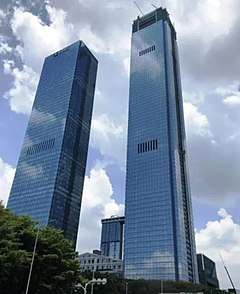Shum Yip Upperhills Tower 1
Shum Yip Upperhills Tower 1 is a supertall skyscraper under construction in Shenzhen, Guangdong, China. It will be 388 metres (1,273.0 ft) tall. Construction started on 12 February 2014 and is expected to be completed in 2019.[1]
| Shum Yip Upperhills Tower 1 | |
|---|---|
深业上城 | |
 | |
| General information | |
| Status | Topped-out |
| Location | Shenzhen, Guangdong |
| Country | China |
| Construction started | 2014 |
| Completed | 2020 |
| Height | |
| Architectural | 388 metres (1,273.0 ft) |
| Tip | 388 metres (1,273.0 ft) |
| Technical details | |
| Structural system | Ladder System |
| Floor count | 80 |
| Design and construction | |
| Architect | Skidmore, Owings & Merrill LLP (SOM) |
| Structural engineer | Skidmore, Owings & Merrill LLP (SOM-NY) |
The tower has a novel structural system called a "Ladder Core System" where the perimeter mega columns are connected to the central reinforced concrete core at every story as opposed to the typical configuration where they are only connected via outriggers at mechanical floors.[2]
Additionally, unlike other supertall skyscrapers with mega-columns, Shum Yip T1 does not have any supplemental gravity columns in the office portion of the tower. The corner framing on either side of the mega-columns is cantilevered 8.5m, which creates a balanced cantilever thus reducing the demand of the middle span a achieving a 28.5m column free span between the two mega-columns on each face. [3]
References
- "Shum Yip Upperhills Tower 1". The Skyscraper Center. Council on Tall Buildings and Urban Habitat. Retrieved January 17, 2015.
- Charles Besjak, Preetam Biswas, Syed Uzair Ullah, Xiaoyu He, Jing Zhuang (2014). "Shenzhen Shum-Yip Tower One – Gravity and Lateral Load Resisting System Optimization". Structures Congress 2014: 2524. doi:10.1061/9780784413357.221. ISBN 9780784413357.CS1 maint: uses authors parameter (link)
- Charles Besjak, Gary Haney, Preetam Biswas, Jing Zhuang, Georgi I. Petrov (2019). "Shenzhen Shum-Yip Tower One : New Supertall Systems Through A-E Collaboration". In AEI 2019: Integrated Building Solutions—The National Agenda. American Society of Civil Engineer. pp. 48–56. doi:10.1061/9780784482261.006.CS1 maint: uses authors parameter (link)